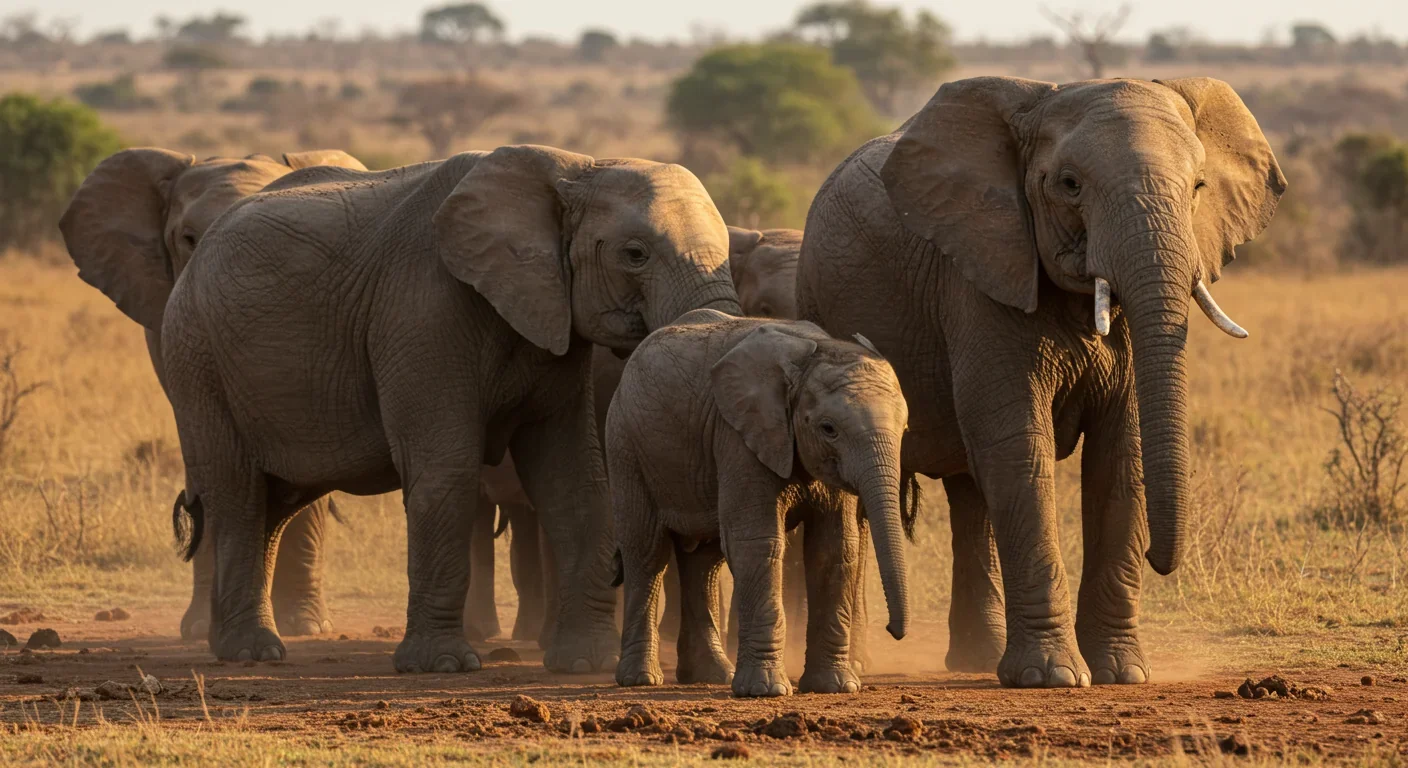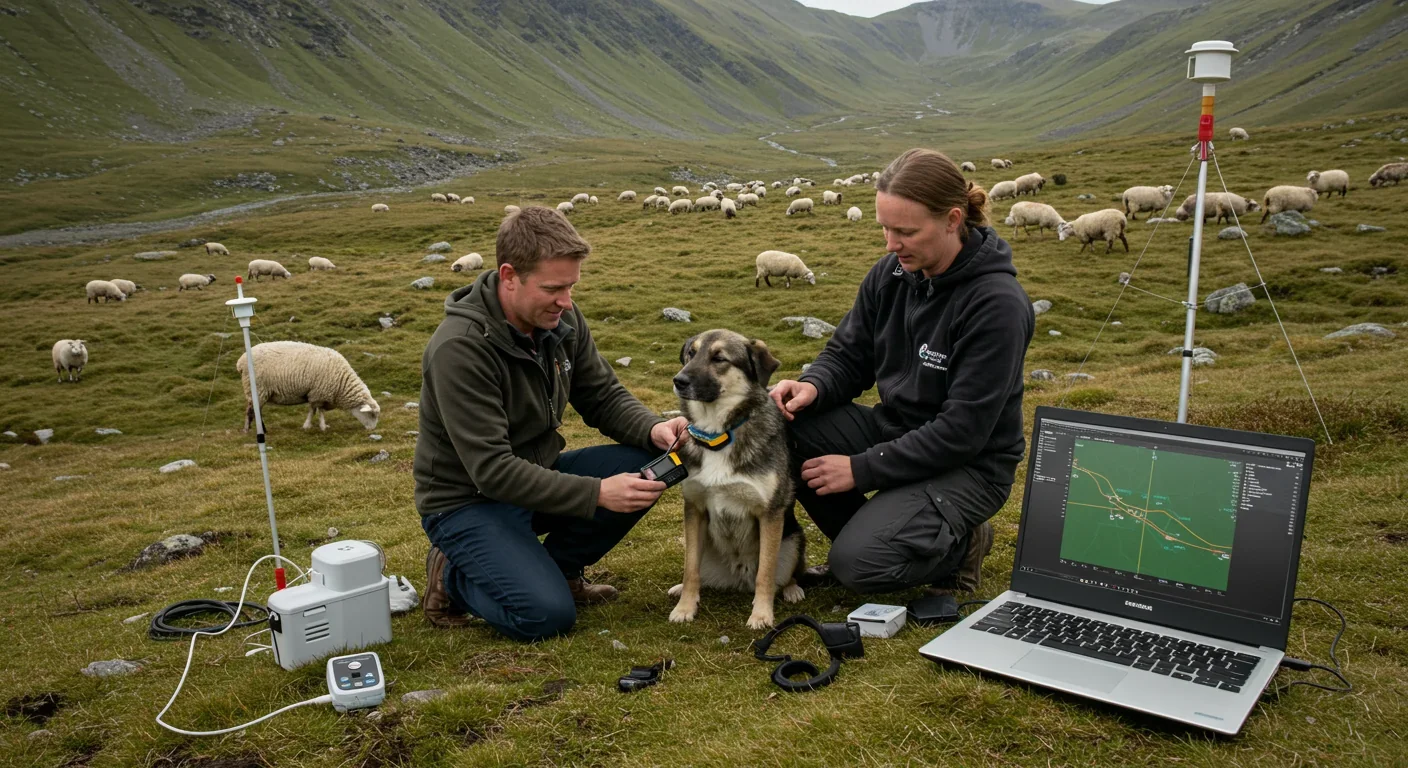Forest Biological Clocks: Ecosystems That Keep Time

TL;DR: Animals can detect earthquakes before humans through enhanced senses like infrasound detection and P-wave sensitivity. Scientific studies show they've predicted major disasters, and new satellite tracking systems could transform them into global early-warning networks.

In February 1975, something extraordinary happened in the Chinese city of Haicheng. Dogs howled incessantly, cattle broke through fences, snakes emerged from hibernation in freezing weather, and thousands of rats swarmed the streets. Local officials, taking these warnings seriously, evacuated 90,000 people. Hours later, a devastating 7.3 magnitude earthquake destroyed 90% of the city. The animal warnings had saved nearly everyone.
This wasn't magic. It was biology we're only beginning to understand.
For centuries, humans dismissed animal earthquake detection as folklore. But modern science is revealing a different story. Recent research from Italy's Abruzzo mountains tracked farm animals over 12 years and found they predicted seven out of eight major earthquakes in the region. On Mount Etna in Sicily, goats wearing GPS trackers have become surprisingly reliable at forecasting volcanic eruptions.
The 2004 Indian Ocean tsunami provided another compelling data point. Before the waves hit, elephants and flamingos fled to higher ground. Wildlife in Sri Lanka's Yala National Park, where hundreds of tourists died, survived almost entirely intact. Not a single elephant carcass was found.
After the 2011 Tohoku earthquake in Japan, researchers surveyed pet owners and discovered that over 18% of dog owners and 16% of cat owners noticed unusual behavior beforehand. The closer pets lived to the epicenter, the more likely they were to act strangely, with behavioral changes appearing anywhere from 1 to 20 hours before the quake.
The mechanisms behind this sixth sense involve capabilities humans simply don't have. Dogs hear frequencies up to 45,000 Hz, while humans max out around 23,000 Hz. This means dogs can detect P-waves, the initial compressional seismic waves that travel faster than the destructive S-waves that cause most earthquake damage. To us, P-waves are imperceptible. To many animals, they're a blaring alarm.
Elephants possess an even more remarkable toolkit. They can detect infrasound, vibrations below 20 Hz that travel through both air and ground. An elephant's feet contain specialized receptor cells that pick up seismic signals from miles away, allowing them to sense approaching threats long before other creatures. This ability evolved for communication across vast distances, but it doubles as an early warning system for natural disasters.
Marine mammals add another dimension to the picture. Before the 2004 tsunami, dolphins in Thailand were observed swimming in agitated circles and heading for deeper water. Their echolocation systems can detect subtle changes in water pressure and density that signal approaching waves.
The physical mechanisms explain immediate warnings, but what about behavioral changes days before an earthquake? Martin Wikelski, director of Germany's Max Planck Institute of Animal Behavior, believes the answer lies in geochemistry. During the buildup to an earthquake, tectonic plates grinding together under immense pressure release ions from crushed rocks into the atmosphere. Animals may be reacting to these chemical signatures.
This hypothesis gained support from a 2013 study of dairy cows near an earthquake site in Japan. Milk production dropped significantly 10 days before the quake, a change researchers attributed to ultra-low-frequency radiation emitted by stressed tectonic plates. The cows weren't predicting the future; they were responding to present environmental changes imperceptible to humans.
Snakes show perhaps the most dramatic pre-earthquake behavior. In China's earthquake-prone regions, snakes have been observed emerging from hibernation in midwinter before major quakes, sometimes freezing to death in the process. Their acute vibration sensitivity, evolved for hunting, makes them extraordinarily responsive to seismic precursors.
Technology is finally catching up to animal intuition. Wikelski is leading an ambitious project to launch a constellation of six satellites that will track GPS-tagged animals worldwide. The system, combining biodiversity monitoring with disaster detection, represents a new approach to early warning systems.
The tags themselves are miniature marvels. Using tiny lithium batteries and GPS chips, they weigh just a few grams, light enough for small birds. The system will monitor not just location but also behavioral patterns, creating a global network of biological sensors.
Initial results are promising. The goats on Mount Etna have proven reliable enough that local authorities now factor their behavior into evacuation planning. The Abruzzo mountain study demonstrated that combining data from multiple species creates a more robust signal than relying on any single animal type.
The challenge now is transforming observations into actionable early warnings. Traditional seismology relies on instruments that measure ground motion and stress changes. Animal behavior offers a complementary approach, one that's distributed across landscapes and potentially more sensitive to precursor signals.
Chinese authorities have been systematically collecting animal behavior data since the Haicheng success, though their results have been mixed. The devastating 1976 Tangshan earthquake, which killed over 240,000 people, occurred with no apparent animal warnings, highlighting the unreliability of behavioral prediction.
This inconsistency doesn't invalidate the phenomenon; it reveals its complexity. Earthquake precursor signals vary by geology, depth, and magnitude. Some quakes produce detectable precursors, others don't. Animals respond to what's there to be sensed, not to the earthquake itself.
Modern machine learning offers new tools for pattern recognition. By analyzing thousands of animal movements in earthquake-prone regions, algorithms can potentially identify subtle behavioral signatures that precede seismic events. The key is building datasets large enough to separate signal from noise.

Different cultures have developed varying levels of trust in animal warnings. In Japan, where earthquakes are frequent and devastating, catfish have long been associated with seismic activity. Modern research has shown that catfish do indeed respond to electromagnetic changes in water before earthquakes, lending scientific credence to folklore.
Indonesia, sitting on the Pacific Ring of Fire, has begun incorporating animal behavior monitoring into community-based disaster preparedness programs. Coastal villages appoint watchers to observe livestock, wildlife, and pets, creating a distributed sensing network that complements official warnings.
Europe's approach has been more skeptical until recently. The Italian studies in Abruzzo and Sicily represent a shift toward systematic investigation, driven by recognition that traditional seismology can't predict earthquakes with the precision needed to save lives. If animals can provide even a few hours of warning, that's enough time for evacuation.
The United States has largely ignored animal behavior in official earthquake preparedness, focusing instead on engineering solutions and immediate emergency response. Yet after every major quake, stories emerge of pets acting strangely beforehand, a recurring pattern that suggests untapped potential.
The practical application doesn't require sophisticated technology. Pet owners in earthquake zones can learn to recognize unusual behaviors: excessive vocalization, reluctance to enter buildings, attempts to escape enclosed spaces, or persistent restlessness without obvious cause.
Community observers can watch for changes in local wildlife: birds leaving an area en masse, livestock refusing to enter barns, or unusual aggregations of animals. These signs won't predict every earthquake, but they cost nothing to monitor and could provide valuable early clues.
The real breakthrough will come from integrating multiple data streams. Imagine a system that combines traditional seismology, GPS-tracked animal movements, community observer reports, and environmental sensors monitoring ion concentrations and electromagnetic fields. Each element alone is imperfect, but together they could form a robust early warning network.
As we develop these systems, ethical questions emerge. Is it right to use animals as living instruments for human safety? The GPS tags are harmless, but the broader project of turning wildlife into a detection network raises concerns about how we relate to the natural world.
Wikelski argues that the satellite tracking serves dual purposes. By monitoring animal movements and health globally, it advances conservation biology while also providing disaster warnings. The animals aren't being exploited for a single human benefit; they're being studied in ways that protect both human and animal populations.
There's also the question of what happens when animals warn us but we ignore them. The Haicheng evacuation succeeded because officials acted on the warnings. But in most places, animal behavior alone wouldn't trigger official action. How do we balance responsiveness with avoiding false alarms that could desensitize populations?
These considerations matter because the technology is advancing rapidly. Within a decade, we could have real-time global animal behavior monitoring. The question isn't whether animals can detect earthquakes, it's how we'll choose to integrate that knowledge into our civilization.
The deeper insight here goes beyond earthquake prediction. We're rediscovering something ancient societies understood intuitively: animals are tuned into environmental signals we've stopped noticing. Modern life insulates us from natural rhythms and warnings that other species still perceive.
This realization has implications for climate change, pollution monitoring, and ecosystem health. Animals don't just react to earthquakes; they respond to dozens of environmental stressors we're only beginning to measure. Flamingos fleeing an area might signal toxic algae blooms. Whales changing migration routes could indicate shifting ocean temperatures. Bees abandoning hives might warn of pesticide contamination before it shows up in tests.
By treating animals as partners rather than subjects, we access information channels we didn't know existed. The technology enables this collaboration, but the mindset shift is what matters most.
The path forward requires investment in infrastructure, research, and community engagement. The satellite constellation is a start, but ground-based monitoring networks need expansion. This means training community observers, deploying environmental sensors in earthquake zones, and developing algorithms that can process diverse data streams in real time.
It also means changing how emergency management systems operate. Current protocols rely on seismometers and geological models. Adding animal behavior to the mix requires new decision-making frameworks, ones that can incorporate probabilistic warnings alongside traditional metrics.
Japan is furthest along in this evolution. Their earthquake early warning system already uses P-wave detection to send alerts seconds before S-waves arrive. Integrating animal behavior monitoring could extend that warning window from seconds to hours, fundamentally changing what's possible in disaster response.
California, sitting on the San Andreas Fault, could implement similar systems. The infrastructure exists: abundant wildlife, a tech-savvy population, and sophisticated emergency management systems. What's missing is the institutional will to take animal warnings seriously.

We need to be clear about what animal detection can and can't do. It won't predict earthquakes days in advance with perfect reliability. The science doesn't support that level of certainty, and claiming otherwise would be dangerous.
What it can do is provide probabilistic early warnings that, combined with other data, improve our chances of getting people to safety. That's not fortune-telling, it's pattern recognition. Animals have evolved over millions of years to detect environmental threats. We're finally developing tools to interpret what they're telling us.
The real transformation happens when we stop seeing this as animal behavior research and start treating it as a new form of environmental awareness. Just as weather satellites changed how we understand climate, animal tracking networks could change how we perceive geological and ecological systems.
The question isn't whether animals can predict earthquakes. They can sense precursors, and sometimes that's enough. The question is whether we're willing to listen, to invest in understanding what they're sensing, and to act on incomplete but valuable information.
In the next five years, expect to see pilot programs in earthquake-prone regions combining animal monitoring with traditional seismology. Japan and Italy will likely lead, followed by Indonesia and parts of South America. Success in these programs could drive broader adoption.
The technology will improve. Smaller tags, longer battery life, and better algorithms will enable monitoring of more species across larger areas. Machine learning will get better at distinguishing meaningful behavioral changes from random fluctuations.
But the biggest variable is human response. Will we take animal warnings seriously enough to act on them? Will communities invest in observer networks? Will emergency management systems adapt their protocols?
The animals are already doing their part, broadcasting warnings we're only beginning to receive. The question is whether we'll tune in before the next big one hits.
The story of animal earthquake detection isn't about mystical powers or primitive superstition. It's about evolved capabilities meeting modern technology, creating possibilities that didn't exist before. We're not replacing science with folklore; we're discovering that folklore often pointed toward science we hadn't understood yet.
As climate change accelerates and natural disasters intensify, we need every advantage we can get. Animals offer us eyes and ears beyond our own senses, warning systems that evolution perfected over eons. Learning to interpret those warnings might be one of the most important technological achievements of the coming decade.
Not because it's magic, but because it's biology we're finally wise enough to understand.

MOND proposes gravity changes at low accelerations, explaining galaxy rotation without dark matter. While it predicts thousands of galaxies correctly, it struggles with clusters and cosmology, keeping the dark matter debate alive.

Ultrafine pollution particles smaller than 100 nanometers can bypass the blood-brain barrier through the olfactory nerve and bloodstream, depositing in brain tissue where they trigger neuroinflammation linked to dementia and neurological disorders, yet remain completely unregulated by current air quality standards.

CAES stores excess renewable energy by compressing air in underground caverns, then releases it through turbines during peak demand. New advanced adiabatic systems achieve 70%+ efficiency, making this decades-old technology suddenly competitive for long-duration grid storage.

Our brains are hardwired to see patterns in randomness, causing the gambler's fallacy—the mistaken belief that past random events influence future probabilities. This cognitive bias costs people millions in casinos, investments, and daily decisions.

Forests operate as synchronized living systems with molecular clocks that coordinate metabolism from individual cells to entire ecosystems, creating rhythmic patterns that affect global carbon cycles and climate feedback loops.

Generation Z is the first cohort to come of age amid a polycrisis - interconnected global failures spanning climate, economy, democracy, and health. This cascading reality is fundamentally reshaping how young people think, plan their lives, and organize for change.

Zero-trust security eliminates implicit network trust by requiring continuous verification of every access request. Organizations are rapidly adopting this architecture to address cloud computing, remote work, and sophisticated threats that rendered perimeter defenses obsolete.